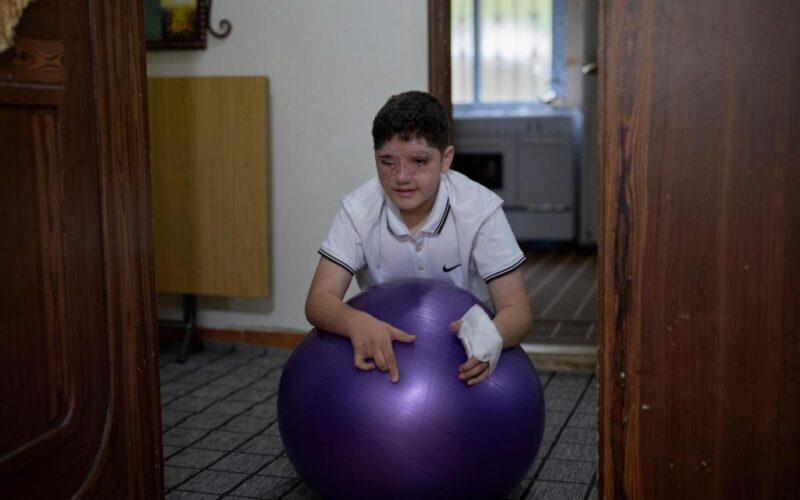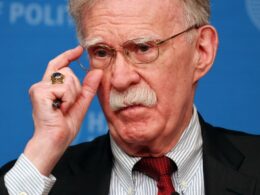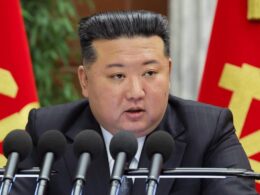By BASSEM MROUE and SARAH EL DEEB, Associated Press
BAZOURIEH, Lebanon (AP) — Her head heavy with a cold, Sarah Jaffal woke up late and shuffled into the kitchen. The silence of the apartment was pierced by the unfamiliar buzzing of a pager lying near a table.
Annoyed but curious, the 21-year-old picked up the device belonging to a family member. She saw a message: “Error,” then “Press OK.”
Jaffal didn’t have time to respond. She didn’t even hear the explosion.
“Suddenly everything went dark,” she said. “I felt I was in a whirlpool.” She was in and out of consciousness for hours, blood streaming from her mouth, excruciating pain in her fingertips.
At that moment on Sept. 17, 2024, thousands of pagers distributed to the Hezbollah group were blowing up in homes, offices, shops and on frontlines across Lebanon, remotely detonated by Israel. Hezbollah had been firing rockets into Israel almost daily for nearly a year in solidarity with Palestinians in Gaza.
After years of planning, Israel had infiltrated the supply chain of Hezbollah, the most powerful of Iran’s armed proxies in the Middle East. It used shell companies to sell the rigged devices to commercial associates of Hezbollah in an operation aimed at disrupting the Iran-backed group’s communication networks and harming and disorienting its members.
The pager attack was stunning in its scope. It wounded more than 3,000 people and killed 12, including two children.
Israel boasts of it as a show of its technological and intelligence prowess. Prime Minister Benjamin Netanyahu recently presented U.S. President Donald Trump with a golden pager as a gift.
Human rights and United Nations reports, however, say the attack may have violated international law, calling it indiscriminate.
Hezbollah, also a major Shiite political party with a wide network of social institutions, has acknowledged that most of those wounded and killed were its fighters or personnel. The simultaneous explosions in populated areas, however, also wounded many civilians like Jaffal, who was one of four women along with 71 men who received medical treatment in Iran. Hezbollah won’t say how many civilians were hurt, but says most were relatives of the group’s personnel or workers in Hezbollah-linked institutions, including hospitals.
Ten months later, survivors are on a slow, painful path to recovery. They are easily identifiable, with missing eyes, faces laced with scars, hands with missing fingers — signs of the moment when they checked the buzzing devices. The scars also mark them as a likely Hezbollah member or a dependent.
Rare interviews
For weeks after the attack, The Associated Press attempted to reach survivors, who stayed out of the public eye. Many spent weeks outside Lebanon for medical treatment. Most in the group’s tight-knit community remained quiet while Hezbollah investigated the massive security breach.
The AP also contacted Hezbollah and its association treating those affected by the attacks to see if they could facilitate contacts. The group, at war with Israel for decades, is also one of the most powerful political factions in Lebanon, with members holding nearly 10% of parliament seats and two ministerial posts. It has its own security apparatus and offers extensive health, religious and other social and commercial services in southern and eastern Lebanon and parts of Beirut.
A representative of Hezbollah’s Association of Wounded did share with AP the contacts of eight people who had expressed readiness to share their stories. The AP independently contacted them, and six agreed to be interviewed. They included Jaffal and another woman, two 12-year-old children and two men, one a preacher, the other a fighter.
All are family members of Hezbollah officials or fighters. All lost fingers. Shrapnel lodged under their skin. The men were blinded. The women and children each lost one eye, with the other damaged.
There were no minders present, and no questions were off-limits. Some declined to answer questions about the identity or role of the pager’s owner, identifying them only as relatives.
The hours of interviews offered a rare glimpse into the attack’s human toll. Survivors described how the incessantly buzzing pagers exploded when picked up, whether they pressed a button or not. Some said their ears still ring from the blast.
”I’ve put up with so much pain I never imagined I could tolerate,” said Jaffal, a university graduate.
The survivors expressed ongoing support for Hezbollah but acknowledged the security breach. They blamed Israel for their wounds.

Rights groups have argued the attack was indiscriminate because the pagers detonated in populated areas, and it was nearly impossible to know who was holding the devices or where they were when they exploded. The preacher, Mustafa Choeib, recalled that his two young daughters used to play with his pager and he sometimes found it among their toys.
Israel’s Mossad spy agency declined to comment on AP questions about those allegations. But Israeli security officials have rejected that the attack was indiscriminate, saying the pagers were exclusively sold to Hezbollah members and that tests were conducted to ensure that only the person holding the pager would be harmed.
A turning point for Hezbollah
The pagers were the opening strike in an Israeli campaign that would cripple Hezbollah.
The day after the pager bombings, Hezbollah walkie-talkies exploded in another Israeli attack that killed at least 25 people and injured over 600, according to Lebanon’s health ministry. Israel then launched a campaign of airstrikes that killed Hezbollah leader Hassan Nasrallah and hundreds of other militants and civilians. The war ended with a ceasefire in November.
Nine months later, Israel stunned and weakened Iran with a campaign of airstrikes that targeted Iranian nuclear sites, senior military officials and symbols of the Islamic Republic’s grip.
Hezbollah, meanwhile, has been left reeling. Besides the military blow, the group is left with the financial and psychological burden of thousands who need long-term medical treatment and recovery.
Pagers are widely seen as outdated, but they were a main part of Hezbollah’s communication network. Nasrallah had repeatedly warned against cellphones. Israel could easily track them, he said.
With old pagers breaking down, the group ordered new ones. Israel sold the rigged devices through shell companies.
According to a Hezbollah official, the group had ordered 15,000 pagers. Only 8,000 arrived, and nearly half were distributed to members. Others destined for Lebanon were intercepted in Turkey days after the attack when Hezbollah tipped off officials there.
Hezbollah’s investigation into how its communications networks were infiltrated found that the purchase of the rigged pagers resulted from negligence, and its officials were cleared of suspicions of collaborating with Israel, the official said, speaking on condition of anonymity to discuss the probe.
Some Hezbollah members had complained the new pagers were too bulky. Some didn’t use them because batteries died quickly or heated up.

Hospitals were like a ‘slaughterhouse’
The simultaneous explosions spread chaos and panic in Lebanon. Hospitals were overwhelmed.
It was like a “slaughterhouse,” Zeinab Mestrah said.
Until she reached a hospital, Mestrah thought an explosion in an electricity cable had blinded her, not the pager of a relative, a Hezbollah member.
“People didn’t recognize each other. Families were shouting out their relatives’ names to identify them,” she recalled from her home in Beirut.
Doctors mainly stopped her bleeding. Five days later, the 26-year-old interior decorator and event planner traveled to Iran for treatment. Her right eye was saved, with shrapnel removed.
The first thing she saw after 10 days of darkness was her mother. She also lost the tips of three fingers on her right hand. Her ears still ring today.
Mestrah said her recovery has delayed plans to find a new career. She realizes she cannot resume her old one.
The next thing she looks forward to is her wedding, to her fiance of eight years.
“He is half my recovery,” she said.
The representative of Hezbollah’s Association of Wounded said none of those injured has fully recovered. He spoke on condition of anonymity because he was not authorized to address the media.

A Hezbollah fighter struck
Mahdi Sheri, a 23-year-old Hezbollah fighter, had been ordered back to the frontline on the day of the attack. Before leaving, he charged his pager and spent time with family. For his security, no mobile phones were allowed in the house while he was there.
There were many drones in the sky that day.
His pager usually vibrated. This time, it beeped. He approached to check for Hezbollah warnings or directives. He saw the message: “Error,” then “Press OK.” He followed the prompt.
He felt a sharp pain in his head and eyes. His bed was covered in blood. Thinking he had been hit by a drone, he stumbled outside and passed out.
He was first treated in Syria, then in Iraq as hospitals in Lebanon struggled to handle the high number of patients. Shrapnel was removed from his left eye socket and he had a prosthetic eye installed.
For a while, he could see shadows with his remaining eye. With time, that dimmed. He can no longer play football. Hezbollah is helping him find a new job. Sheri realizes it’s impossible now to find a role alongside Hezbollah fighters.
He asked his fiancée if she wanted to move on. She refused. They married during a video call while he was in Iraq, a month after his injury.
“Nothing stood in our way,” Sheri said. He moves between southern Lebanon and Beirut’s southern suburbs, where his wife lives and studies to be a nurse.
The community is shaken. Some children fear coming near their fathers, he said.
“It not only affects us but also those around us.”

A boy with a face full of scars
In southern Lebanon, 12-year-old Hussein Dheini picked up the pager that belonged to his father, a Hezbollah member. The explosion cost the boy his right eye and damaged his left. It blew off the tips of two fingers on his right hand. On his left hand, the pinky and middle finger remain.
His teeth were blown out. His grandmother picked them off the couch, along with the tip of his nose.
“It was a nightmare,” said his mother, Faten Haidar.
The boy, a member of Hezbollah scouts, the group’s youth movement, had been talented at reciting the Quran. Now he struggles to pace his breathing. He can read with one eye but is quickly exhausted. The family has moved to a ground-floor apartment so he climbs fewer stairs.
He wears glasses now. Pink scars crisscross his face and his reconstructed nose. He spends more time with other children injured like him, and only goes to school for exams. Dheini can’t go swimming with his father, since sea or river water could harm his wounds.
“Before, I used to spend a lot of time on my phone. I used to run and go to school,” the boy said. “Now I go to Beirut” for treatment.
Impatience to rebuild a life
Jaffal has had 45 surgeries in nine months. More will come, including reconstructive surgery on her face and fingers. Two fingers are fused. Four are missing.
She is waiting for a prosthetic right eye. Further surgeries on her left one have been delayed. She can recognize people and places she knows, though she relies more on memory than vision.
The loss of sensation in her fingertips is disorienting. The nerve pain elsewhere is sharp. Weekly physiotherapy reminds her of how much is still ahead.
The driven, inquisitive woman leans on her faith to summon patience.
“God only burdens us with what we can bear,” she said.
She has spoken in religious gatherings at Hezbollah’s invitation about her recovery and resilience. Her biggest fear is becoming dependent.
An information technology graduate, she used to produce videos of family celebrations and events — a career she wanted to explore. Now she watches videos on her phone, though they are blurry.
She giggles to ease the discomfort, and enjoys taking the lead when meeting with fellow victims because she can see better than most.
“I forget my wounds when I see another wounded,” she said.
Associated Press writer Josef Federman in Jerusalem contributed to this report.
Originally Published:








